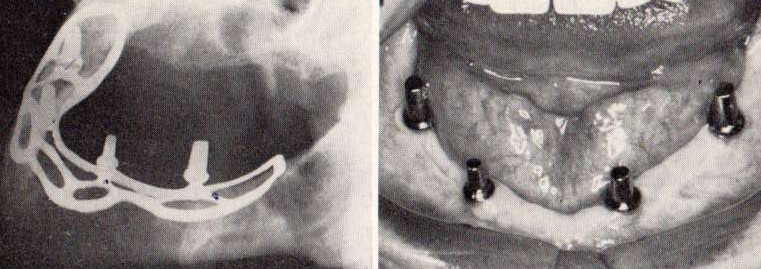Implants
Dentures on implants have been available for around twenty five years. Todays implant technology is far more advanced than it was twenty years ago with titanium being the main metal in the business. The illustration to the right highlights the early 1970's subperiosteal implants with the possibility of rejection and the structure rising to the surface.
Todays implants are avialable in a miscellany of types, manufacturers and available to be re-designed to cope with changes in treatment plan as bridges emerge from crowns to bridges then onto partial dentures then eventually full dentures.
Implants are basically artificial metal roots that can either be reinserted immediately following a tooth extraction or reamered into position at a predetermined point in time.
Following the insertion into the prepared bone a period of osseointegration takes place were the bone and implant form a joint. With advances, this period has been drastically reduced making the whole system quick treatment.
Todays implant surgery is performed with painless precision under local aneasthetic.
If requested to your family dentist will refer you to a specialist implantologist who will provide a full examination treatment plan and cost. These services are usually private. Following your implant placement the implant gum margin require frequent followup inspections to ensure hygiene by removing any residual plaque.
Root Prepared teeth
When patients have roots left in the gum then the Doldar bar on the far right was an early preferred technique. The bar being supported between two root prepared teeth. As long as the canines teeth were present then this design could be utilized.
Site under constructiion

The following methods of full lower denture retention require the use of the patients natural root being present, although it can be substituted for an implant in the future.

Magnet retained appliances utilize a high yeild magnetic system requiring expensive technology as illustrated below.

The above diagram illustrates the two sections
1. The assembly in the mouth permanently placed in the root.
2. The removable assembly located in the fitting surface of the denture.
The relationship between the natural root, with the root cap inserted in the root containing the keeper. The active conponent, the Magnet, is located in the denture from ehich a high attractive force locates the magnet and keeper together.
The magnets life span can be notably reduced where corrosion occurs and therefore it is imperative the conponents are kept spotlessly clean. Likewise they must not be scratched especially the magnet.
The diagram below illustrates the typical placement of magnets on a full lower denture.
